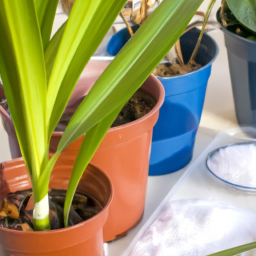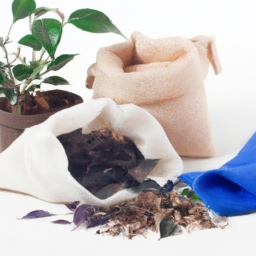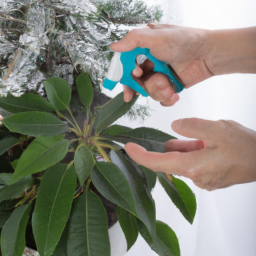
Winter can be a challenging time for indoor plants. As the days grow shorter and temperatures drop, their growth slows down, and their nutrient requirements change. This leads to a common question among plant enthusiasts: should indoor plants be fertilized in the winter? While some may assume that plants don’t need fertilizer during this dormant period, others argue that providing nutrients is essential for their overall health and vitality. In this blog post, we will explore the pros and cons of fertilizing indoor plants during the winter months and provide some helpful tips to ensure your leafy companions thrive throughout the colder season. So, let’s dive in and shed some light on this intriguing topic!
The Importance of Fertilizing Indoor Plants During Winter
Winter can be a challenging time for indoor plants. With the colder temperatures and reduced sunlight, their growth slows down, and they may struggle to stay healthy. One way to support your indoor plants during this time is through proper fertilization. In this article, we will explore the importance of fertilizing indoor plants during winter and provide you with a step-by-step guide on how to do it effectively.
Why Fertilize Indoor Plants in Winter?
1. Nutrient Deficiency:
During winter, indoor plants receive less natural light, which affects their ability to photosynthesize and produce energy. This reduced energy production can lead to nutrient deficiencies, as plants require essential nutrients to carry out their metabolic processes. Fertilizing your indoor plants during winter replenishes these nutrients and ensures their overall health and well-being.
2. Promote Growth:
While indoor plants may experience slower growth during winter, they still require some nutrients to support their limited growth. Fertilizing your plants provides them with the necessary nutrients to maintain their growth and prevent stagnation. It helps them maintain their vitality, ensuring they are ready to flourish when spring arrives.
3. Maintain Aesthetic Appeal:
Indoor plants are not just a source of fresh air; they also enhance the aesthetic appeal of your living space. Fertilizing your plants during winter helps them retain their vibrant foliage and prevents them from becoming pale or dull. It ensures that your indoor plants continue to add beauty and color to your home throughout the winter season.
Step-by-Step Guide to Fertilizing Indoor Plants in Winter
1. Choose the Right Fertilizer:
When selecting a fertilizer for your indoor plants, consider using a balanced, water-soluble fertilizer. Look for a fertilizer with a ratio of equal parts nitrogen (N), phosphorus (P), and potassium (K). This balanced formula provides essential macronutrients to support overall plant health.
2. Dilute the Fertilizer:
Follow the instructions on the fertilizer package to determine the appropriate dilution ratio. It is crucial not to over-fertilize your plants, as this can lead to nutrient burn or other adverse effects. Dilute the fertilizer in water according to the recommended ratio, ensuring it is thoroughly mixed.
3. Water the Plants:
Prior to fertilizing, water your indoor plants thoroughly. This helps prevent fertilizer burn by ensuring the soil is adequately moistened and ready to receive the nutrients. Allow the excess water to drain out before proceeding with fertilization.
4. Apply the Fertilizer:
Using a watering can or spray bottle, apply the diluted fertilizer to the soil around the base of the plant. Avoid directly spraying the foliage, as this can lead to leaf burn. Ensure the fertilizer is evenly distributed, covering the entire root zone.
5. Monitor and Adjust:
Keep an eye on your plants after fertilization. Observe their response to the fertilizer and make adjustments if necessary. If you notice any signs of over-fertilization, such as wilting or yellowing leaves, reduce the frequency or concentration of fertilizer application.
6. Maintain Consistency:
Consistency is key when fertilizing indoor plants during winter. Aim to fertilize your plants every 4-6 weeks, as this allows for a steady supply of nutrients without overwhelming the plants. Avoid fertilizing during periods of dormancy or when the plants show signs of stress.
7. Provide Adequate Lighting:
While fertilization is important, it is equally crucial to provide adequate lighting for your indoor plants during winter. Place them near a window where they can receive as much natural light as possible. If natural light is limited, consider using artificial grow lights to supplement their lighting needs.
8. Adjust Watering Routine:
Remember that fertilizing indoor plants affects their watering needs. As the plants receive additional nutrients, they may require more frequent watering. Monitor the moisture levels in the soil and adjust your watering routine accordingly, ensuring the plants neither dry out nor become waterlogged.
By following these steps and providing your indoor plants with the necessary nutrients during winter, you can help them thrive and maintain their health and beauty throughout the colder months. Remember to observe your plants closely and make adjustments as needed to ensure their individual requirements are met. With proper care and attention, your indoor plants will reward you with their lush foliage and vibrant presence, even in the depths of winter.

Tips for Fertilizing Indoor Plants in the Winter Season
Winter can be a challenging time for indoor plants. With the colder temperatures and reduced sunlight, plants often go into a dormant state, requiring less water and nutrients. However, this doesn’t mean that you should completely neglect fertilizing your indoor plants during this season. In fact, providing the right nutrients can help your plants stay healthy and vibrant throughout the winter months. In this article, we will explore some tips for fertilizing indoor plants in the winter season.
Understanding the Needs of Indoor Plants in Winter
Before we dive into the specifics of fertilizing indoor plants in winter, it’s important to understand the needs of your plants during this season. Most indoor plants experience slower growth during winter due to reduced sunlight and lower temperatures. As a result, their nutrient requirements may change. While it’s true that plants require less fertilizer during this time, they still need a balanced supply of essential nutrients to thrive.
During winter, it’s crucial to choose a fertilizer that is specifically formulated for indoor plants. Look for a balanced fertilizer with equal amounts of nitrogen (N), phosphorus (P), and potassium (K). These three nutrients are essential for plant growth and development. Additionally, make sure the fertilizer is water-soluble, as this will ensure proper absorption by the plants.
Now that we have a basic understanding of the needs of indoor plants in winter, let’s move on to the step-by-step guide for fertilizing them during this season.
Step 1: Assess the Plant’s Nutrient Requirements
The first step in fertilizing indoor plants in winter is to assess their nutrient requirements. This can be done by observing the plant’s overall health and growth. If the plant appears healthy and is growing at a steady pace, it may not require additional fertilization. However, if the plant is showing signs of nutrient deficiency, such as pale leaves or stunted growth, it’s time to provide some extra nutrients.
It’s important to note that over-fertilizing can be harmful to plants, so it’s better to err on the side of caution. Start with a small amount of fertilizer and gradually increase the dosage if needed. Remember, it’s always easier to add more fertilizer later than to undo the damage caused by excessive fertilization.
Once you have assessed the plant’s nutrient requirements, it’s time to move on to step 2.
Step 2: Choose the Right Fertilizer
Choosing the right fertilizer is crucial for the health and well-being of your indoor plants. As mentioned earlier, opt for a balanced fertilizer with equal amounts of nitrogen, phosphorus, and potassium. This will provide the necessary nutrients for healthy plant growth.
There are various types of fertilizers available in the market, including liquid, granular, and slow-release fertilizers. Liquid fertilizers are popular for indoor plants as they are easy to use and quickly absorbed by the plants. However, if you prefer a low-maintenance option, slow-release fertilizers can be a good choice. These fertilizers release nutrients gradually over time, providing a steady supply of nourishment to the plants.
Once you have chosen the right fertilizer, it’s time to move on to step 3.
Step 3: Fertilizing Indoor Plants in Winter
Now that you have assessed the plant’s nutrient requirements and chosen the right fertilizer, it’s time to fertilize your indoor plants. Here’s a step-by-step guide to help you through the process:
1. Prepare the fertilizer: Follow the instructions on the fertilizer packaging to prepare the appropriate dilution. It’s important not to exceed the recommended dosage, as this can harm the plants.
2. Water the plants: Before applying the fertilizer, water the plants thoroughly. This will help prevent the roots from burning and ensure proper absorption of nutrients.
3. Apply the fertilizer: Pour the prepared fertilizer solution evenly around the base of the plants. Avoid getting the fertilizer on the leaves, as this can cause damage.
4. Monitor the plants: After fertilizing, closely monitor the plants for any signs of stress or over-fertilization. If you notice any adverse effects, such as wilting or yellowing leaves, adjust the fertilizer dosage accordingly.
5. Maintain a regular fertilization schedule: Fertilizing indoor plants in winter should be done less frequently compared to other seasons. Aim to fertilize your plants once every 4-6 weeks, depending on their specific needs.
By following these steps, you can ensure that your indoor plants receive the necessary nutrients to thrive during the winter season.
In conclusion, while indoor plants may require less fertilization during winter, providing them with the right nutrients is still essential for their overall health and well-being. By understanding their needs, choosing the right fertilizer, and following a proper fertilization schedule, you can help your indoor plants stay healthy and vibrant throughout the colder months. Remember, each plant is unique, so it’s important to observe and adjust your fertilization practices accordingly. Happy gardening!

Should Indoor Plants Be Fertilized in the Winter?
Introduction
As winter sets in, many indoor plant owners wonder whether they should continue fertilizing their beloved green companions. While it may seem counterintuitive to feed plants during the dormant season, providing proper nutrients can actually benefit their overall health and vitality. However, there are a few common mistakes that you should avoid when fertilizing indoor plants in winter. In this article, we will explore these mistakes and provide you with a step-by-step guide to ensure your indoor plants thrive throughout the colder months.
The Importance of Winter Fertilization
Contrary to popular belief, indoor plants do not go completely dormant during winter. While their growth may slow down, they still require essential nutrients to maintain their health and prepare for the upcoming spring growth spurt. Fertilizing your indoor plants during winter helps replenish any nutrients that may have been depleted and sets the stage for vigorous growth when the warmer months arrive.
However, it is crucial to understand that the fertilization needs of indoor plants differ from those of outdoor plants. Indoor plants are confined to pots and have limited access to natural nutrients present in the soil. Therefore, providing them with a balanced fertilizer in the right amounts becomes even more critical during the winter months.
Common Mistakes to Avoid
1. Over-Fertilization
One of the most common mistakes indoor plant owners make is over-fertilization. While it may seem like providing extra nutrients will benefit the plants, excess fertilizer can actually harm them. Over-fertilization can lead to salt build-up in the soil, causing root burn and nutrient imbalances. During winter, when plants are already experiencing slower growth, over-fertilization can further stress them and hinder their ability to absorb water and nutrients.
To avoid over-fertilization, it is essential to follow the instructions provided on the fertilizer packaging. Use a balanced, slow-release fertilizer specifically formulated for indoor plants. Remember, less is more when it comes to fertilizing during winter.
If you notice signs of over-fertilization such as leaf burn or stunted growth, flush the soil with water to remove excess salts and adjust your fertilization schedule accordingly.
2. Neglecting Light and Temperature Requirements
Light and temperature play a crucial role in the growth and nutrient uptake of indoor plants. During winter, the intensity and duration of natural light decrease, which affects the plants’ metabolic activity. Therefore, it is important to adjust your fertilization routine to match the reduced light levels.
Indoor plants generally require less fertilizer during winter due to their slower growth. If your plants receive less natural light during this season, reduce the frequency and dosage of fertilization accordingly. Pay attention to any specific light requirements of your plants and ensure they receive adequate light to support healthy growth.
Moreover, indoor temperatures tend to fluctuate during winter, particularly if you use heating systems. Extreme temperature variations can stress plants and affect their nutrient uptake. Make sure to place your indoor plants away from drafts and maintain a consistent temperature range suitable for their specific species.
3. Lack of Proper Watering
Proper watering is essential for the overall health and nutrient absorption of indoor plants, especially during winter. Many indoor plant owners tend to reduce watering frequency during this season, which can lead to dry soil and hinder nutrient uptake.
Before fertilizing your indoor plants, always check the moisture level of the soil. If the soil feels dry, water your plants thoroughly and allow excess water to drain out. This ensures that the roots can effectively absorb the nutrients provided by the fertilizer.
However, be cautious not to overwater your plants, as this can lead to root rot and other moisture-related issues. Strike a balance between proper watering and fertilization to create an optimal environment for your indoor plants.
Conclusion
Fertilizing indoor plants during winter is indeed beneficial for their overall health and growth. By avoiding common mistakes such as over-fertilization, neglecting light and temperature requirements, and lack of proper watering, you can ensure that your indoor plants remain vibrant and thrive throughout the colder months.
Remember to always follow the instructions provided by the fertilizer manufacturer and adjust your fertilization routine based on the specific needs of your plants. With proper care and attention, your indoor plants will reward you with lush foliage and beautiful blooms, even during the winter season.
In a Nutshell
During the winter months, many indoor plant owners wonder if they should continue fertilizing their leafy friends. While it may seem logical to assume that plants don’t require as much nutrients during this dormant season, the truth is that indoor plants still benefit from a little extra boost. Fertilizing indoor plants in the winter can help promote healthy growth, prevent nutrient deficiencies, and ensure they thrive when spring arrives.
Indoor plants rely on us to provide them with the necessary nutrients, as they don’t have access to the natural elements like outdoor plants do. Even though they may not be actively growing during the winter, they still need some nourishment to maintain their overall health. However, it’s important to adjust the fertilization routine to match the plant’s needs during this time. Using a diluted fertilizer and reducing the frequency of application can help prevent overfeeding and potential damage to the plant’s roots. By providing the right amount of nutrients, indoor plants can continue to flourish and bring a touch of greenery to our homes even in the winter months.
Here are this week’s Top Questions and Answers
Q1: Should indoor plants be fertilized in the winter?
A1: It depends on the specific needs of your indoor plants. In general, most indoor plants experience slower growth during the winter months due to reduced sunlight and lower temperatures. Therefore, fertilizing them may not be necessary or even beneficial. However, some plants may still benefit from a small amount of fertilizer to support their limited growth during this time.
Q2: What are the potential benefits of fertilizing indoor plants in winter?
A2: Fertilizing indoor plants during winter can provide them with essential nutrients that may be lacking in their environment. It can help promote healthier foliage, stronger root development, and overall plant vitality. Additionally, if you have flowering plants, fertilizing them during winter might encourage them to bloom more abundantly when spring arrives.
Q3: Are there any risks associated with fertilizing indoor plants in winter?
A3: Yes, there are some risks involved. Since most indoor plants experience slower growth and reduced water requirements during winter, over-fertilizing can lead to nutrient buildup in the soil, causing root burn or other plant health issues. It’s crucial to follow the recommended dosage and frequency specified on the fertilizer packaging or consult a gardening expert to avoid these risks.
Q4: How often should indoor plants be fertilized during winter?
A4: Indoor plants generally require less frequent fertilization during winter compared to the growing season. It’s recommended to fertilize them at half the strength and half the frequency of what you would use during the active growing months. For example, if you usually fertilize your plants every two weeks, switch to once a month or every six weeks during winter.
Q5: What type of fertilizer is best for indoor plants in winter?
A5: The choice of fertilizer depends on the specific needs of your indoor plants. Generally, a balanced, water-soluble fertilizer with a ratio of equal parts nitrogen (N), phosphorus (P), and potassium (K) is suitable for most indoor plants during winter. However, it’s always a good idea to check the specific fertilizer requirements for each plant species to ensure you’re providing the right nutrients in the right proportions.

James Wong is a renowned ethnobotanist, plant scientist, and local television presenter. With a passion for demystifying plant science, he is known for translating complex botanical concepts into practical advice for everyday plant enthusiasts. James’s expertise spans from traditional gardening to cutting-edge plant technologies, making his insights accessible and informative.


